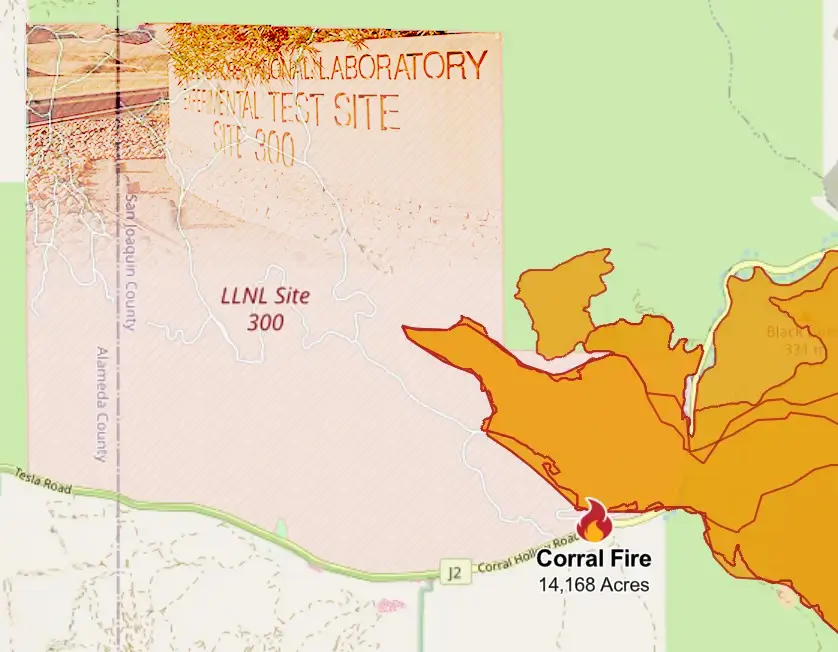 Tri-Valley CAREs recently followed up with Lawrence Livermore National Laboratory (LLNL) staff members on July 23rd who gave a presentation about the Corral Fire that occurred in June and how it affected the cleanup infrastructure at the Site 300 High Explosives Testing Range (among other topics).
Tri-Valley CAREs recently followed up with Lawrence Livermore National Laboratory (LLNL) staff members on July 23rd who gave a presentation about the Corral Fire that occurred in June and how it affected the cleanup infrastructure at the Site 300 High Explosives Testing Range (among other topics).
The fire, which began on June 1st on the Site 300 property, quickly grew to cover 14,168 acres and burned a portion of Site 300 before moving off-site. Immediately after the Corral Fire began, LLNL officials put out statements that they were not responsible for the fire. Much of the media did not mention that part of the Site 300 property burned or that the fire started on site. Four days prior to the ignition of the Corral Fire, a planned, controlled burn was conducted at Site 300 to lessen the likelihood of fire damage in the future. However, the controlled burn reportedly was not completed, otherwise it could have significantly minimized the damage of the Corral Fire. In fact, the Corral Fire purportedly burned the area again or at least the entire area around the controlled burn. Despite the close timing of the controlled burn and the Corral Fire, lab officials as well as Alameda Fire have stated that the two were unrelated. The exact location where the fire started has been identified, but the cause is still under investigation (both by LLNL and by Cal Fire). If these investigations are not publicly available, Tri-Valley CAREs will formally request them.
LLNL has a Smoke Management Plan, which does not mention contaminants such as depleted uranium and PCBs that are both present in the soil and groundwater at Site 300, and are a concern of Tri-Valley CAREs. These substances can transform into other compounds when exposed to high levels of heat, including furan and dioxin, which are both extremely toxic. Any fire, controlled or not, at Site 300 has the capacity to spread these dangerous compounds into the air, thus disturbing the surrounding environment.
During Tri-Valley CAREs’ meeting with lab officials, a presentation was given which discussed the ongoing soil and groundwater cleanup at Site 300 and the Corral Fire’s impact on that cleanup. Most notably, a pipeline carrying contaminated groundwater burst (830-DISS), releasing approximately 6,000 gallons of untreated groundwater (containing perchlorate and VOCs) onto the soil. The final ERD assessment, which only includes damages pertaining to the soil/groundwater cleanup, is still underway.
The news reported that damages of the fire were only one house and two injured firefighters, but the Corral Fire’s impact on Site 300 was significant. It started near Building 892, and the flames quickly spread southeast, damaging numerous Operable Units (OUs) and facilities, and extending to a grand total of 14,168 acres.
- All 10 pump-and-treat systems in Operational Units (OU) 1, 2, and 7 were impacted.
- Twenty-one monitoring wells were put out of commission.
- Several pipelines running between the wells and OUs were damaged, one of which (830-DISS) resulted in a 6,000-gallon contaminated leak containing perchlorate and VOCs.
- Accumulated damage resulted in several systems being temporarily shut down, including 834 SVTS. This was restarted on June 18th, operating 10 out of the 14 SVE wells.
- The 833-SSDS (sub-slab depressurization system) was significantly damaged and needs to be replaced. A permanent, updated system is scheduled for sometime this year.
- Two unused on-site buildings burned.
- Vapor Extraction System (VES) 13, operating near Building 833, was significantly damaged.
These damages were not publicly reported and were only uncovered during the presentation organized by Tri-Valley CAREs. Up until this point, the impact of the Corral Fire on Site 300 was not included in any media. Additoinally, the presentation focused on damage to cleanup infrastucture and did not cover damages to programmatic infrastucture on the site.
Tri-Valley CAREs concerns about Site 300’s wildfire risk is increasing due to climate change affects. Wildfires have also threatened similar nuclear weapon sites, such as Los Alamos National Laboratory in New Mexico in recent years. The potential impacts of a fire at such locations could include the release of radioactive/toxic smoke. In the case of Site 300, the ignition of high explosives is also a risk.
Tri-Valley CAREs will continue to seek out information and post updates regarding the fire. Stay tuned for more!
